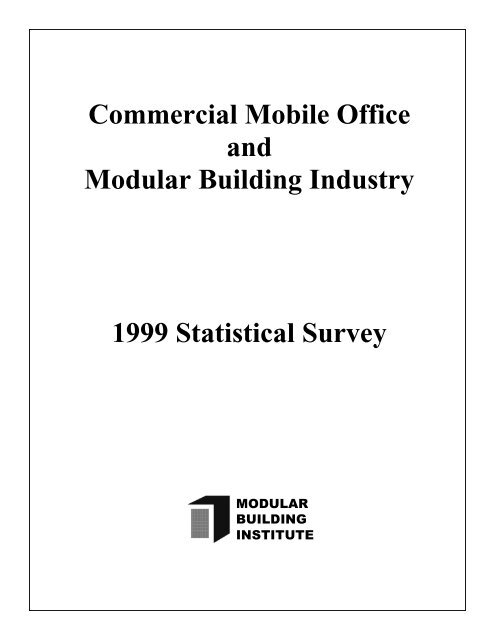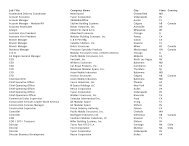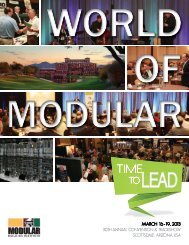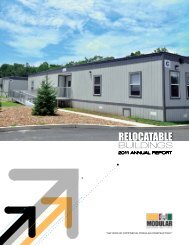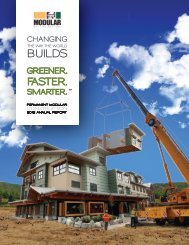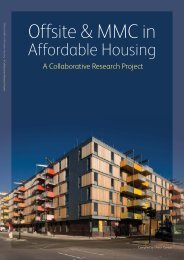1999 Statistical Survey - Modular Building Institute
1999 Statistical Survey - Modular Building Institute
1999 Statistical Survey - Modular Building Institute
Create successful ePaper yourself
Turn your PDF publications into a flip-book with our unique Google optimized e-Paper software.
Commercial Mobile Office<br />
and<br />
<strong>Modular</strong> <strong>Building</strong> Industry<br />
<strong>1999</strong> <strong>Statistical</strong> <strong>Survey</strong><br />
MODULAR<br />
BUILDING<br />
INSTITUTE
Commercial Mobile Office<br />
and<br />
<strong>Modular</strong> <strong>Building</strong> Industry<br />
<strong>1999</strong> <strong>Statistical</strong> <strong>Survey</strong><br />
Prepared by:<br />
MODULAR<br />
BUILDING<br />
INSTITUTE<br />
Judy M. Smith, CMP, Executive Director<br />
413 Park Street, Charlottesville, Virginia 22902<br />
Phone: (804) 296-3288 Fax: (804) 296-3361<br />
E-mail: info@mbinet.org Internet: www.mbinet.org<br />
© August 2000, <strong>Modular</strong> <strong>Building</strong> <strong>Institute</strong><br />
The <strong>1999</strong> <strong>Statistical</strong> <strong>Survey</strong> is the property of the <strong>Modular</strong> <strong>Building</strong> <strong>Institute</strong>. It may not be reprinted or copied by any means without the<br />
express written permission of the <strong>Modular</strong> <strong>Building</strong> <strong>Institute</strong>. Copies are available by contacting the <strong>Modular</strong> <strong>Building</strong> <strong>Institute</strong>.
Table of Contents<br />
I. INTRODUCTION<br />
A. <strong>Modular</strong> <strong>Building</strong> <strong>Institute</strong>: Annual <strong>Survey</strong> 1<br />
B. General Industry Description 1<br />
C. <strong>Survey</strong> Methodology 3<br />
D. Review of Descriptive Statistics 4<br />
II.<br />
MANUFACTURER RESULTS<br />
A. Floors Shipped in <strong>1999</strong> 6<br />
B. Total Square Feet 7<br />
C. <strong>1999</strong> Gross Sales 8<br />
D. Warranty Expense 9<br />
E. Sales by Market Segment 9<br />
F. Other Data 10<br />
III.<br />
DEALER RESULTS<br />
A. <strong>1999</strong> Dealer Gross Revenue 12<br />
B. Lease Fleet Composition 15<br />
C. Lease Fleet Utilization 16<br />
D. Sale of Used Units 17<br />
IV.<br />
INTEGRATED RESULTS<br />
A. Manufacturing Data 18<br />
B. Integrated Dealer Data 19<br />
V. CONCLUSIONS<br />
A. Selected Data Recap 20<br />
B. <strong>1999</strong> Industry Estimates 20<br />
C. Residual Values 21<br />
D. Future <strong>Survey</strong>s 21
I. INTRODUCTION<br />
A. <strong>Modular</strong> <strong>Building</strong> <strong>Institute</strong>: Annual <strong>Survey</strong><br />
The <strong>Modular</strong> <strong>Building</strong> <strong>Institute</strong> ("MBI" or the "Association") is the industry trade<br />
association representing manufacturers, suppliers and dealers of commercial factory built<br />
structures. During spring 2000, the MBI prepared and distributed survey questionnaires to both<br />
member and non-member manufacturers and dealers (the "<strong>1999</strong> <strong>Statistical</strong> <strong>Survey</strong>"). The <strong>1999</strong><br />
<strong>Statistical</strong> <strong>Survey</strong> is the eighth survey conducted by the Association. In each of the six prior<br />
years, a similar survey was conducted by the Association covering calendar years 1993 to 1998<br />
and on October 1, 1991, results of a comprehensive 1990 industry survey were released. The<br />
MBI intends to conduct an annual survey of manufacturers and dealers as a device to chart<br />
industry growth and as a tool to benefit member organizations.<br />
B. General Industry Description<br />
Commercial <strong>Modular</strong> <strong>Building</strong>s are non-residential factory built structures generally<br />
designed to meet federal, state and local building codes and are capable of being relocated. The<br />
commercial modular building industry is comprised of four distinct participants:<br />
* Independent Manufacturers;<br />
* Integrated companies (dealers with captive manufacturing capabilities);<br />
* Independent Dealers; and<br />
* Suppliers to the dealers and manufacturers.<br />
The vast majority of manufacturers are private, independent single-location facilities.<br />
Manufacturers generally operate as wholesale suppliers of modular buildings to industry dealers.<br />
The wholesale manufacturers respond to dealer requests for quotations and build both mobile<br />
offices and customized modular buildings. Manufacturers that either maintain their own lease<br />
fleet or sell new and used mobile offices and modular buildings directly to retail customers are<br />
referred to as integrated companies.<br />
Independent dealers respond to retail customer requirements for mobile and modular<br />
space. The dealers lease or sell new and used modular buildings and mobile offices. Dealers<br />
generally work with a customer to complete a space plan, order a new building from a<br />
manufacturer and arrange for delivery and installation of the building. Dealers may subcontract<br />
the delivery and installation or perform the work with their own personnel. Dealers range in size<br />
from single location sales operations with little or no lease fleet to large, well-capitalized lessors<br />
with sales offices nationwide.<br />
Suppliers include component suppliers such as plywood, steel, heating and air<br />
conditioning systems, frames, chassis, plumbing and electrical fixtures as well as freight<br />
companies, installation crews, financing, insurance and bonding companies.<br />
- 1 -
The mobile and modular building industry, with its roots in construction trailers, has<br />
expanded over the years to include a multitude of uses where speed of occupancy, relocatability<br />
and the temporary need for space are primary market drivers. The industry responds to an ever<br />
increasing need to provide timely delivery of flexible and complex commercial structures. An<br />
end user's annual budgeting or appropriation process fits squarely with the primary market<br />
drivers of the industry: flexibility of design and the ability to rapidly deliver temporary space in a<br />
cost-effective manner. The modular buildings and mobile offices are not "land attached" and can<br />
generally be moved from one site to another site that later becomes more usable or profitable.<br />
Shifting demographics play a significant role in the relocatability of these structures, particularly<br />
for the educational markets.<br />
The modular building industry can be divided into two major segments: single and<br />
doublewide factory built buildings generally leased on a short-term basis (together referred to<br />
herein as "Mobile Offices") and multi-unit (three or more) modular buildings ("<strong>Modular</strong><br />
<strong>Building</strong>s") typically leased for longer terms. The Mobile Office and <strong>Modular</strong> <strong>Building</strong> segments<br />
will be referred to collectively as the "modular building industry."<br />
Individual Mobile Offices vary in size, with the smallest measuring 8' x 16' and the<br />
largest 18' x 84'. Typical construction is wood frame mounted on a steel chassis, with fixed or<br />
removable axles and hitches. These offices are generally built to the same model building code<br />
as those built on-site. With normal maintenance a Mobile Office will last indefinitely. While<br />
generally built to one of three national model building codes, mobile offices may be land-locked<br />
in the state(s) in which they bear a state seal indicating compliance with that states current<br />
version of the building codes. Mobile Offices intended for rental on construction sites are<br />
deemed to be “temporary” and generally do not have a state seal. Mobile Offices intended for<br />
use at a site other than a construction site generally do have a state seal(s). <strong>Building</strong> code<br />
enforcement procedures are assumed by state agencies which may contract their duties to<br />
independent third party inspection agencies. While state codes and procedures differ, there is<br />
growing state to state code compliance reciprocity. The typical rental period for single mobile<br />
offices other than classrooms is between three and eighteen months. Classrooms usually remain<br />
on lease with a single lessee for periods well in excess of thirty-six months.<br />
In addition to construction site offices, individual Mobile Offices are used as classrooms,<br />
in-plant offices and general commercial offices. Specialty mobile units function as<br />
office/storage combinations, toilet units, showers, decontamination units, change units,<br />
restaurants, diners, fast food buildings, equipment shelters and branch banks.<br />
Unlike Mobile Offices, which generally offer standard floor plans and standard features,<br />
<strong>Modular</strong> <strong>Building</strong>s are often designed and built to meet the specific requirements of the initial<br />
end user. <strong>Modular</strong> <strong>Building</strong>s provide high quality, rapidly built, relocatable or permanent<br />
solutions to the space demands of a broad client base. Simultaneous manufacturing and site<br />
work often allows modular building occupancy to occur much faster than traditional methods of<br />
construction. A shorter construction period can reduce both construction period financing and<br />
supervision costs and can put the building to work sooner. Nearly all engineering, design, and<br />
architectural disciplines are part of the manufacturing team, thereby eliminating the time<br />
consuming involvement of outside engineers and consultants.<br />
- 2 -
Combining the design flexibility of traditional building methods with the quality of<br />
controlled manufacturing, the industry has refined a construction process which provides speed,<br />
economics, and architectural aesthetics. Historically, <strong>Modular</strong> <strong>Building</strong>s have been used as<br />
hospital and diagnostic health care facilities, educational facilities, daycare centers, correctional<br />
facilities, banks, commercial office buildings and in a variety of high tech fast-growth industries.<br />
These practical, time and money saving alternatives to site-built buildings effectively meet the<br />
specialized needs of diverse businesses. Customers served by <strong>Modular</strong> <strong>Building</strong>s include<br />
federal, state and local governments, school boards, corporations, non-profit organizations,<br />
Indian tribes, quasi-government entities like the U.S. Postal Service, as well as individuals,<br />
partnerships, and sole proprietorships. Other uses include medical facilities, airport facilities,<br />
military installations, restaurants, retail businesses and remote telecommunications switch<br />
stations. Some facilities are used as an adjunct to existing buildings while others are stand-alone<br />
buildings. Flexibility and reutilization are the hallmarks of modular buildings. Unlike structures<br />
built on-site which generally have fixed utilization and occupancy design, modular units fulfill a<br />
unique function of reutilization that is not site specific. It is not unusual to have a <strong>Modular</strong><br />
<strong>Building</strong> serve a wide variety of users during its long life span.<br />
Since users of the relocatable buildings are diverse, specific industry slowdowns do not<br />
significantly impact sales and leasing companies. The flexibility of these buildings makes them a<br />
secure investment. During severe economic downturns, these conditions allow lessors to enjoy<br />
cash flows adequate to service debt. This flexibility is further enhanced by the ability to relocate<br />
buildings to more prosperous cities or industries as opportunities arise. Certain market segments<br />
of the industry are counter-cyclical. This is particularly true of education, prisons, and<br />
governmental agencies that want to transfer funding for facility needs from capital expenditures<br />
to operating budgets. This concept also applies to industries which may want to expand, but are<br />
uncertain about the long-term strength of their growth. Budget driven companies often opt for<br />
leased facilities. In such cases <strong>Modular</strong> <strong>Building</strong>s offer benefits and options without long-term<br />
capital commitments.<br />
In late 1993 the Florida Department of Education released the results of a comprehensive<br />
study of The Use of Relocatable Classrooms in the Public School Districts of Florida. This<br />
research report from the Florida Office of Education Facilities was prepared based on the results<br />
of surveys sent to superintendents and facility planners in all 67 counties, over 1,300 teachers,<br />
site visits to schools and factories as well as meetings with industry representatives. Over<br />
sixteen thousand (16,000) relocatable classrooms were reported to be in use in Florida in 1993.<br />
The average age of those units was reported as 19 years. Each of the 67 counties had some<br />
relocatable classrooms. Facilities planners expected a service life of 23 years with many in place<br />
beyond 40 years. “This study has found that the primary advantages of the relocatable<br />
classroom are its ability to provide flexible, suitable short-term accommodation for Florida's<br />
growing student population and its ability to provide that accommodation incrementally, in a<br />
timely and cost efficient manner." (Emphasis added.)<br />
C. <strong>Survey</strong> Methodology<br />
The MBI Membership Committee in cooperation with the Board of Directors maintains<br />
an updated list of industry participants. During May 2000, the MBI prepared survey<br />
questionnaires for all member and prospective-member dealers, integrated companies and<br />
- 3 -
manufacturers. Prior to 1998, integrated companies (those that manufacture, lease and sell<br />
directly to retail customers) received both dealer and manufacturer questionnaires. This is the<br />
second year that integrated companies received their own questionnaire. As a result, for the first<br />
time, separate integrated company results can be compared to prior year results. Questionnaires<br />
were mailed by the MBI to the following number of industry participants:<br />
Dealers Integrated Manufacturers<br />
MBI Members 54 22 30<br />
Prospective Members 171 72 135<br />
Total 225 94 165<br />
These recipients represent all companies engaged in business in our industry which are<br />
included in the MBI database. Responses were received from twenty (20) dealers, nine (9)<br />
integrated manufacturing companies and twenty-one (21) wholesale manufacturers. Thus, the<br />
response rate based on the number of questionnaires mailed was 8.9% for dealers, 9.6% for<br />
integrated companies and 12.7% for manufacturers. Weighted response rates based on size of<br />
the respondents could not be calculated as the MBI received only averages or totals without the<br />
benefit of individual company information.<br />
PFS Corporation, an independent company providing quality control, testing, inspection<br />
and certification services for the modular building industry tabulated the results. The survey was<br />
conducted on a double blind basis. PFS did not have company names associated with the<br />
responses and the MBI did not receive the individual responses. The original survey responses<br />
will be held by PFS Corporation and are not available to the public or to MBI officers, members<br />
or management staff.<br />
Only those responses answering the specific question(s) were included in any tabulation.<br />
"Zero" responses were counted as non-responses and were not included in the sample for<br />
calculating averages and other statistics.<br />
D. Review of Descriptive Statistics<br />
PFS Corporation tabulated the questionnaire results and provided the MBI with totals and<br />
number of responses for each total. PFS Corporation also provided certain range and<br />
concentration data as requested.<br />
An "average" can be calculated using three different methods. The mean is the numerical<br />
average, which is the sum of the responses divided by the number of responses. "Mean" is the<br />
most commonly understood meaning of average. The median is the response that lies in the<br />
middle of a sequence, i.e., the value above and below which there are an equal number of<br />
responses (regardless of the values of those responses). The mode is the most frequently<br />
occurring response. The mean and median are provided throughout this report. The mode is<br />
reported when meaningful.<br />
In a sample or population that has a normal or "bell-shaped" frequency distribution, the<br />
mean, median and mode all have the same value. This generally occurs when there are a large<br />
number of similar responses. "Similar" is a relative term. Similarity among observations is<br />
- 4 -
eported as a standard deviation, which measures the dispersal or scatteredness of the<br />
observations. A sample population with a normal distribution has 68% of the observations<br />
within one standard deviation of the mean, and 95% of the observations within two standard<br />
deviations of the mean. When a small number of atypical observations distort the mean relative<br />
to the median and mode, the distribution is skewed. This generally occurs when there are a small<br />
number of responses or when the responses contain a significant outlayer. By way of example, if<br />
survey results provide significantly different measures of average lease fleet size, then the<br />
population has a wide distribution (lots of dealers with 400 units and one dealer with 60,000<br />
units). WHEN THE POPULATION IS SKEWED, A MEDIAN AVERAGE GENERALLY<br />
PROVIDES A BETTER ESTIMATE OF THE “AVERAGE” RESPONDENT.<br />
Calculation of the appropriate “average” is essential in the quest to ascertain the size of<br />
the commercial modular building industry. If we were curious as to the total number of Mobile<br />
Offices and <strong>Modular</strong> <strong>Building</strong>s in active lease fleets, the most accurate measure would be if all<br />
industry participants would truthfully disclose the number of units in their own lease fleet at a<br />
given point in time. Since this is not feasible, a reasonable method to estimate the total number<br />
of units in domestic lease fleets is to calculate a reliable average and multiply by the number of<br />
active industry participants. Accuracy of this estimate is a function of numerous factors<br />
including clarity of the questions asked, veracity of the responses, confidence in the measure of<br />
the calculated averages and estimate of the total number of industry participants.<br />
- 5 -
II. MANUFACTURER RESULTS<br />
The <strong>1999</strong> Manufacturer Questionnaire requested total number of floors produced and<br />
shipped in <strong>1999</strong> together with break-out detail over various size categories; total square footage<br />
shipped in <strong>1999</strong>; <strong>1999</strong> gross sales; and both <strong>1999</strong> and 1998 warranty expenses.<br />
A. Floors Shipped in <strong>1999</strong><br />
Twenty-one (21) respondents reported 21,541 total floors shipped in <strong>1999</strong>. The mean<br />
(mathematical average) was 1,026 floors and the median average (middle of the ordered<br />
responses) was 548 floors. The 1998 mean average was 1,158 and the median was 686. Thus,<br />
both measures of average decreased in <strong>1999</strong>. The largest respondent in terms of <strong>1999</strong> floors<br />
shipped was 18.6% of the total while the five largest accounted for 62.7% of the total.<br />
Wholesale Manufacturer Floors Produced<br />
Year Total Mean Median<br />
<strong>1999</strong> 21,541 1,026 548<br />
1998 18,534 1,158 686<br />
1997* 23,243 830 498<br />
*1997 figures include integrated manufacturers.<br />
The <strong>1999</strong> MBI mean and median floors shipped were checked for reasonableness by<br />
comparing the computed averages with those generated by the <strong>1999</strong> survey of special unit<br />
producers conducted by Automated Builder magazine (see March 2000 issue). Special unit<br />
producers that manufacture modular or panelized commercial buildings reported <strong>1999</strong><br />
production to Automated Builder of 10,384 floors with a mean of 692 floors and a median of 400<br />
floors. The <strong>1999</strong> averages are down from the 1998 Automated Builder mean of 822 and median<br />
of 570.<br />
Floors Shipped Automated<br />
<strong>1999</strong> MBI <strong>Survey</strong> Builder<br />
Mean 1,026 692<br />
Median 548 400<br />
Total floors shipped by category in <strong>1999</strong> were calculated on the basis of the floors for<br />
which category information was provided. Seventy-nine percent (79.4%) shipped were Mobile<br />
Offices (singles and doubles) while twenty-one percent (20.6%) were <strong>Modular</strong> <strong>Building</strong>s divided<br />
between triples (8.8%), single story complexes (9.6%) and multi-story complexes (2.2%). In<br />
1998, singles accounted for 47%, doubles 29.7% (together 76.7%); triples 10.1%, single story<br />
complexes 12% and multi-story complexes 1.2%. Thus, although the Mobile Office percentage<br />
increased from 1998 to <strong>1999</strong>, the composition was skewed to the doublewide. Interestingly, the<br />
percentage of multi-story complex units reported doubled from 1998 to <strong>1999</strong>.<br />
- 6 -
Wholesale Manufacturers<br />
<strong>1999</strong> Floors Produced by Type<br />
Multi-story<br />
2.2%<br />
1-story<br />
9.6%<br />
Singles<br />
38.6%<br />
Triples<br />
8.8%<br />
Doubles<br />
40.8%<br />
In 1997, Mobile Offices accounted for 83% of total floors shipped and in 1996, Mobile<br />
Offices accounted for 78% of total floors shipped. Category information for the prior three years<br />
is set forth below. 1997 and 1996 percentages include integrated manufacturers.<br />
Percent of Floors Shipped by Wholesale Manufacturers<br />
Category <strong>1999</strong> 1998 1997 1996<br />
Single 38 47 29 43<br />
Doublewide 41 30 54 35<br />
Triplewide 9 10 6 6<br />
One Story Complex 10 12 11 13<br />
Multi-Story Complex 2 . 1 . 0 . 3 .<br />
100% 100% 100% 100%<br />
<strong>1999</strong> respondents to the manufacturing survey reported shipping significantly more<br />
doublewide units than in the prior year. The increase in doublewide unit shipments was offset by<br />
the decrease in single unit shipments from 47% in 1998 to 38% in <strong>1999</strong>.<br />
B. Total Square Feet<br />
Sixteen (16) respondents reported a total of 8.16 million square feet shipped in <strong>1999</strong> up<br />
from 7.98 million in the prior year. The <strong>1999</strong> mean was 510,110 square feet and the median was<br />
352,031. Both are well below prior year averages of 665,148 (mean) and 438,342 (median).<br />
Once again, <strong>1999</strong> responses were widely scattered with a large standard deviation indicating the<br />
presence of significant outlayers in the sample.<br />
- 7 -
Based on median square feet of 352,031 and an MBI estimated 165 domestic<br />
wholesale manufacturers, the wholesale industry shipped approximately 58 million<br />
square feet of new commercial factory built Mobile Offices and <strong>Modular</strong> <strong>Building</strong>s in<br />
<strong>1999</strong>, a 25% decrease from 1998 survey results.<br />
C. <strong>1999</strong> Gross Sales<br />
Wholesale Manufacturers* Square Feet Shipped (000’s)<br />
Total Averages<br />
Reported Mean Median<br />
<strong>1999</strong> 8,162 510 352<br />
1998 7,982 665 438<br />
1997 12,371 476 286<br />
1996 9,030 311 181<br />
1995 8,800 353 268<br />
1994 7,000 259 198<br />
*1997-1994 figures include integrated manufacturers.<br />
Twenty-one (21) respondents reported <strong>1999</strong> gross sales attributable to floors<br />
shipped was $293.6 million. The mean average per respondent was $14.0 million while<br />
the median average was $10.7 million. A high standard deviation indicates the responses<br />
were widely scattered. <strong>1999</strong> mean average gross sales were down from $17.8 million in<br />
1998 while the median average declined from $14.3 million in the prior year.<br />
Wholesale Manufacturer Gross Sales (in Millions)<br />
Year Total Mean Median<br />
<strong>1999</strong> $293.6 $14.0 $10.7<br />
1998 267.5 17.8 14.3<br />
1997* 403.9 14.4 8.0<br />
*1997 includes integrated manufacturers.<br />
If the reported <strong>1999</strong> gross sales for each respondent were divided by the number<br />
of floors produced for that respondent, we can look at a rough measure of sales price per<br />
floor. The range of prices per floor was a low of $2,230 to a high of $54,688 with a mean<br />
average of $13,628 and a median average of $18,350. Caution must be used in analyzing<br />
this data as the reported gross sales figures may include revenues from items other than<br />
sales of floors and the percentage of other revenues included for each respondent may be<br />
different. In addition, this survey treats all floors alike although there is certainly a<br />
dramatic price difference between a stock 8’ x 16’ and a custom floor which can be as<br />
large as 18’ x 84’. In light of these caveats, the range of prices per floor is<br />
understandable. Moreover, the calculated price per average floor correlates very highly<br />
with the percentage of custom floors reported by each manufacturer. Lower average<br />
prices per floor are generally stock units while higher prices are custom buildings.<br />
- 8 -
In order to eliminate the bias created by different floor sizes, reported <strong>1999</strong> gross sales<br />
were divided by square feet produced for each respondent to generate sales per square foot.<br />
Sales per square foot ranged from $12.39 to $46.44 with a mean average of $29.48 and a median<br />
average of $29.84. In 1998, sales per square foot ranged from $12.59 to $41.43 with a mean of<br />
$28.81 and a median of $28.22.<br />
Average sales multiplied by the estimated number of domestic wholesale manufacturers<br />
in the MBI database generates an estimate of <strong>1999</strong> sales.<br />
Mean $14.0 million x 165 = $2.31 billion<br />
Median $10.7 million x 165 = $1.77 billion<br />
Given a large standard deviation, the <strong>1999</strong> median average is probably a more reliable<br />
statistic. Thus, estimated industry sales by wholesale manufacturers is approximately $1.77<br />
billion in <strong>1999</strong>, an decrease of 33% from the prior year’s estimate.<br />
In the Automated Builder <strong>1999</strong> survey, nineteen respondents reported aggregate gross<br />
revenue of $258 million with a mean average of $13.6 million and a median average of $6.6<br />
million. The <strong>1999</strong> Automated Builder mean differs by only 2.9% from the MBI mean while the<br />
median differs by 62% from the MBI result.<br />
D. Warranty Expense<br />
<strong>1999</strong> Gross Sales<br />
MBI <strong>Survey</strong> Automated Builder<br />
Respondents 21 19<br />
Total Gross Revenue $ 293.6 million $ 258.0 million<br />
Mean Average $ 14.0 million $ 13.6 million<br />
Median Average $ 10.7 million $ 6.6 million<br />
Seventeen (17) respondents reported <strong>1999</strong> warranty expenses ranged from .2% to 3% of<br />
gross revenues with a mean average of 1.3% and a median average of .9%. The same<br />
respondents reported 1998 warranty expenses ranged from .2 to 3% of gross revenues with a<br />
mean average of 1.1% and a median average of .7%.<br />
E. Sales by Market Segment<br />
Manufacturers were asked to break out the percentage of gross sales by end use market<br />
segment for <strong>1999</strong>. The percentages were multiplied by the number of units produced for each<br />
manufacturer to get a unit weighted distribution.<br />
- 9 -
<strong>1999</strong> Sales by Market Segment<br />
Daycare<br />
1.6%<br />
Construction<br />
Trailer<br />
16.7%<br />
Restroom<br />
1.4%<br />
Storage<br />
11.2%<br />
Health Care<br />
2.1%<br />
Residential<br />
24.7%<br />
Other<br />
2.8%<br />
F. Other Data<br />
Education<br />
17.1%<br />
Single Story<br />
Complex<br />
22.4%<br />
Manufacturers were asked to provide responses to the following questions:<br />
a) average number of employees in <strong>1999</strong>;<br />
b) estimated total production hours in <strong>1999</strong>;<br />
c) % of units shipped on time as promised at order;<br />
d) slowest month of production as a percent of largest month;<br />
e) shipments were made into how many states;<br />
f) ninety percent (90%) of business conducted within how many miles of plant; and<br />
g) five largest customers constitute what percent of business.<br />
The mean and median averages for 1997 to <strong>1999</strong> are set forth below:<br />
Mean Average<br />
Median Average<br />
<strong>1999</strong> 1998 1997 <strong>1999</strong> 1998 1997<br />
Total Employees 120 135 101 92 86 85<br />
Production Hours (Thousands) 221 243 216 157 132 84<br />
On Time Delivery 87% 88% 83% 90% 90% 88%<br />
Slow Month/High Month 42% 40% 44% 40% 31% 40%<br />
Number States Shipped 8 13 6 8 9 4<br />
Average Ship Radius (Miles) 305 383 329 250 275 250<br />
Five Largest Customers 67% 65% 68% 80% 79% 80%<br />
- 10 -
The mean average number of employees decreased from 135 in 1998 to 120 in <strong>1999</strong><br />
while the median average increased from 86 to 92. The trend was the same for total production<br />
hours year to year; the mean average decreased from 243,000 to 221,000 while the median<br />
average increased from 132,000 to 157,000.<br />
The percentage of units shipped “on time” remained constant at 90% (87% mean<br />
average) while the slowest month production as a percentage of largest month production<br />
increased to 40% (42% mean average). The five largest customers accounted for 80% of the<br />
wholesale manufacturer’s business based on the median average and two-thirds based on the<br />
mean average. While these figures were not production weighted, the larger manufacturers<br />
exhibited greater customer diversity.<br />
Manufacturers were also asked to list the “biggest problems” encountered in <strong>1999</strong>. The<br />
problems listed by manufacturers together with the frequency of responses (a manufacturer could<br />
list more than one problem) were:<br />
Labor Shortage 6<br />
Managing Production Volume 3<br />
Inconsistent Backlogs 3<br />
Regional/Stock Order Slowdowns 2<br />
Summary—Wholesale Manufacturers<br />
Mean<br />
<strong>1999</strong> MBI Averages<br />
Median<br />
Gross Sales (millions) $14.0 $10.7<br />
Floors Shipped in <strong>1999</strong> 1,026 548<br />
Square Feet Produced 510,110 352,031<br />
Gross Sales/Floors Produced $13,628 $18,350<br />
Gross Sales/Square Feet $29.48 $29.84<br />
- 11 -
III. DEALER RESULTS<br />
The <strong>1999</strong> Dealer Questionnaire requested total floors in the lease fleet at December 31,<br />
<strong>1999</strong> together with break out information by various size categories; fleet utilization by category;<br />
average sales price (as % of original cost) of used units together with the average age; <strong>1999</strong> gross<br />
revenue detail and market segment information.<br />
A. <strong>1999</strong> Dealer Gross Revenue<br />
Twenty (20) dealers reported total <strong>1999</strong> gross revenue of $560.7 million, down from<br />
$807.5 million reported by twenty-five (25) dealers in 1998. The decrease in total dealer gross<br />
revenue from 1998 to <strong>1999</strong> is attributable solely to the composition of respondents in each sample.<br />
The total figures are essentially meaningless. Mean <strong>1999</strong> dealer gross revenue was $28.0 million<br />
while median revenue was $5.2 million. The data contains a large standard deviation which<br />
indicates widely scattered responses wherein median revenue is generally a more accurate measure<br />
of average.<br />
Dealer Average Gross Revenue (in Millions)<br />
MBI <strong>Survey</strong> Mean Median<br />
<strong>1999</strong> $28.0 $5.2<br />
1998 32.3 2.8<br />
1997 7.0 5.0<br />
1996 16.7 4.4<br />
1995 11.2 2.9<br />
1994 12.0 3.2<br />
The <strong>1999</strong> mean average of $28.0 million is below the 1998 mean of $32.3 million. The<br />
<strong>1999</strong> median average is well above both the 1998 median of $2.8 million and the 1997 median of<br />
$5.0 million. The <strong>1999</strong> sample has a smaller dispersion of responses resulting in a tightening of<br />
the averages. The 1998 sample included two disproportionate responses on the top side which<br />
inflated the mean while the <strong>1999</strong> sample included only one of the two.<br />
Despite the “averages” coming closer together than in 1998, the large discrepancy between<br />
the mean and the median <strong>1999</strong> dealer gross revenue averages indicates a small sample with a wide<br />
variance in the responses. The highest reported total gross revenue figure is more than 2,459 times<br />
the smallest. Even more startling, the highest reported <strong>1999</strong> gross rent figure is 41,613 times the<br />
smallest. The composition of total dealer revenue (in thousands) by type together with the <strong>1999</strong><br />
mean average and the <strong>1999</strong> median average is set forth on the following page.<br />
- 12 -
<strong>1999</strong> Dealer Gross Revenues (in Thousands)<br />
Reported Total Mean Average Median Average<br />
Rental Income 263,525 15,501 2,150<br />
Sales, New 127,420 6,706 2,375<br />
Sales, Used 34,147 2,439 684<br />
Freight In/Out 32,218 2,014 225<br />
Set-Up/Dismantle 57,261 4,090 511<br />
Service 4,856 405 185<br />
Other 41,299 4,130 325<br />
Total 560,726 28,036* 5,185*<br />
*Average columns do not add up as number of respondents differed for each category.<br />
Rental income accounted for 47% of total reported <strong>1999</strong> dealer revenue, down from 50%<br />
in 1998 but well over the 38.5% from 1997. While mean rental income was $15.5 million, down<br />
from $20.2 million in 1998, median rental income increased threefold from 700 thousand in 1998<br />
to $2.15 million in <strong>1999</strong>. Sales of new units rose from 17.9% of 1998 total dealer revenue to<br />
22.7% of <strong>1999</strong> total revenue. Both measures of average also increased year to year with the<br />
mean moving from $6.0 million to $6.7 million and the median from $2.0 million in 1998 to<br />
$2.38 million in <strong>1999</strong>.<br />
Set-up and dismantle revenue as a percentage of total <strong>1999</strong> dealer revenue more than<br />
doubled from 4.9% in 1998 to 10.2% in <strong>1999</strong>. Not surprisingly, both measures of average dealer<br />
set-up and dismantle rose significantly with the mean rising from $2.5 million in 1998 to $4.1<br />
million in <strong>1999</strong> and the median from 225 thousand to 511 thousand over the same period.<br />
The increase in set-up and dismantle revenue was absorbed by large decreases in sales of<br />
used units, freight revenue and service and maintenance revenue. Sales of used units declined<br />
from 10.1% of total 1998 revenue to 6.1% of total <strong>1999</strong> revenue. Although the mean average<br />
declined from $3.7 million to $2.4 million, the median actually rose from 231 thousand to 684<br />
thousand. Likewise, freight revenue declined from 9.6% of 1998 total dealer revenue to 5.7% of<br />
<strong>1999</strong> revenue. Just as with used sales, the mean average declined ($4.3 million to $2.0 million)<br />
while the median increased ($74 thousand to $225 thousand). Service and maintenance revenue<br />
dropped from 2.9% of total 1998 revenue to only .9% of <strong>1999</strong> total revenue with the same<br />
impact on both measures of average.<br />
“Other” increased substantially in terms of overall percentage and for both averages.<br />
This is probably due to the inclusion of one substantial abnormal response which heavily skewed<br />
the results. If this outlier were eliminated, mean other revenue drops to $437 thousand from $4.1<br />
million and the median declines from the reported $325 thousand to $150 thousand. In addition,<br />
if the single deviant “other” response is eliminated, the overall composition of total <strong>1999</strong> dealer<br />
gross revenue is impacted; rental income rises to 50.4% of the adjusted total, new sales 24.3%;<br />
used sales 6.5%; freight 6.2%; set-up 10.9%; service .9%; and other drops to .8%.<br />
- 13 -
By eliminating the outlying “other” response and focusing on median averages, it is<br />
possible to get a good look at the revenue sources for an “average” dealer. The average dealer<br />
generated $6.3 million gross revenue in <strong>1999</strong> from rental income (34.3%); sales of new units<br />
(37.8%); sale of used units (10.9%); freight (3.6%); set-up and dismantle (8.1%); service (2.9%);<br />
and other (2.4%).<br />
Source of <strong>1999</strong> Gross Revenues, Percent of Total*<br />
Sales-Used<br />
6.5%<br />
Set-up/Dismantle<br />
10.9%<br />
Service<br />
.9%<br />
Other<br />
.8%<br />
Freight<br />
6.2%<br />
Rents<br />
50.4%<br />
Sales-New<br />
24.3%<br />
*Data adjusted for one abnormal “other” response.<br />
<strong>Survey</strong> respondents were asked to allocate total <strong>1999</strong> gross revenues over nine market<br />
segments. The percentages from each respondent were than multiplied by that respondents<br />
reported total revenue in order to provide the appropriate weight to each response. This<br />
weighting of responses provides a better picture of market participation than in prior years<br />
surveys.<br />
Dealer Market Segments, Median <strong>1999</strong> Averages<br />
State Government<br />
1.1%<br />
General Office<br />
17.9%<br />
Construction<br />
39.7%<br />
Other<br />
.9%<br />
Bank<br />
.1%<br />
Education<br />
31.2%<br />
Federal<br />
Government<br />
5.8%<br />
Health<br />
2.7%<br />
- 14 -<br />
Day Care<br />
.6%
Field offices for construction sites remains the largest market segment for dealers in<br />
<strong>1999</strong>. Nearly 40% of <strong>1999</strong> dealer revenues were derived from the construction marketplace.<br />
Dealers reported a wide range of dependence on this segment, from a low of 0% of annual gross<br />
revenues to a high of 100% with a mean of 34% and a median of 24%. Education provided<br />
31.2% of total reported <strong>1999</strong> dealer gross revenue with a mean of 19%, a median of 19% and a<br />
range of 0 to 100% of annual gross revenues. General office constituted 17.9% of <strong>1999</strong> dealer<br />
revenues. Coupled with construction and education, the three largest markets accounted for<br />
nearly 90% of annual dealer revenue.<br />
Gross Dealer Revenue was derived from the following markets in the past three years.<br />
Revenue Source* <strong>1999</strong> Percent 1998 Percent 1997 Percent<br />
Construction 40 34 29<br />
Education 31 26 29<br />
General Office 18 17 17<br />
Health Care 3 3 2<br />
Other 1 6 5<br />
Federal Government 6 3 5<br />
State Government 1 4 5<br />
Banks - 4 6<br />
Day Care - 3 2<br />
Total 100% 100% 100%<br />
*1998 and <strong>1999</strong> figures are unweighted.<br />
B. Lease Fleet Composition<br />
Dealers reported a total of 108,827 units in their lease fleets at December 31, <strong>1999</strong>, down<br />
from 154,366 reported last year. The mean average was 6,402 units per dealer down from<br />
11,877 in 1998 while the median average was 675, up from 480 the prior year. The data<br />
indicates a large standard deviation which implies that the individual responses were widely<br />
scattered with significant outlayers. The median was very low relative to the mean indicating<br />
that relatively few respondents had very large numbers of modular units in their lease fleets. The<br />
lease fleet of the two largest respondents in <strong>1999</strong> comprised more than 84% of the total floors in<br />
the sample indicating a substantial skew. Indeed, the largest reported fleet was 26,449 times<br />
larger than the smallest in <strong>1999</strong>. Thus, the median is a far better estimate of the size of a typical<br />
industry participant's lease fleet.<br />
Units Per Dealer Lease Fleet<br />
<strong>1999</strong> 1998 1997 1996<br />
Mean (weighted average) 6,402 11,877 4,069 3,718<br />
Median (middle response) 675 480 627 624<br />
- 15 -
The single unit, leased for a variety of uses including a construction site field office,<br />
classroom, sales office or bank building, accounted for 47% of total <strong>1999</strong> dealer lease fleets,<br />
while containers, storage units and over the road trailers accounted for 19.3% of total units.<br />
Together, the containers, storage units, over the road trailers and singles represented nearly twothirds<br />
of total reported units. Doublewides accounted for 19.0% of dealer fleets, down from the<br />
1998 share of 19.6%. Triples were fairly level with prior years at 1.6% while single story<br />
complexes increased from 5.3% in 1998 to 11.9% in <strong>1999</strong>.<br />
Percent of Mobile Offices and <strong>Modular</strong> <strong>Building</strong>s<br />
In Lease Fleets at December 31, <strong>1999</strong><br />
Triples<br />
1.6%<br />
Doubles<br />
19%<br />
Singles<br />
47%<br />
Other<br />
1.1% Containers<br />
12.4%<br />
2-story<br />
.2%<br />
C. Lease Fleet Utilization<br />
Single Story<br />
Complexes<br />
11.9%<br />
Over the Road<br />
1.5%<br />
Storage<br />
5.4%<br />
Eighty-five percent (84.7%) of all Mobile Offices and <strong>Modular</strong> <strong>Building</strong>s available for<br />
lease were actually on lease at December 31, <strong>1999</strong>, an increase from the 81.5% reported at the<br />
end of 1998. The results in 1998 were skewed by a relatively large number of “other” units with<br />
a low utilization. If the “other” category in 1998 were removed, aggregate weighted utilization<br />
rises in 1998 to 84%.<br />
Percent of Mobile Offices and <strong>Modular</strong> <strong>Building</strong>s on Lease at December 31<br />
<strong>1999</strong> 1998 1997 1996 1995 1994<br />
Single* 82 84 90 87 82 83<br />
Double 89 76 92 87 83 76<br />
Triple/Quad 83 77 88 84 88 75<br />
Complex 87 88 88 96 95 79 .<br />
Total** 85 82 90 87 84 83<br />
*<strong>1999</strong> includes containers 86%; storage 84%; over-the-road 88%.<br />
**Weighted average.<br />
- 16 -
D. Sale of Used Units<br />
<strong>Survey</strong> respondents reported that they sold used Mobile Offices and <strong>Modular</strong> <strong>Building</strong>s<br />
in <strong>1999</strong> for a mean average 111% of original cost. The median average was 115% of original<br />
cost and the sample had a very small standard deviation.<br />
The mean age of used units sold in <strong>1999</strong> was 8 years and the median age was 7 years<br />
with a symmetrical but broad distribution.<br />
The <strong>1999</strong> results are very consistent with those reported in prior years. In 1998, used<br />
units were reported as sold for 104% (mean) of original cost with a median of 110% of original<br />
cost.<br />
Mean Average Average<br />
MBI <strong>Survey</strong> Sales Price* Age in Years<br />
<strong>1999</strong> 111 8.0<br />
1998 104 8.8<br />
1997 102 7.5<br />
1996 99 8.2<br />
1995 97 6.8<br />
1994 85 6.5<br />
*Percent of original cost.<br />
The survey was not designed to provide data to correlate age and sale prices of used<br />
modules. While the data might have been so used, there was no significant correlation. Although<br />
one might intuitively expect older buildings to sell for less than newer buildings, maintenance<br />
and other external factors appear to have a greater impact on the sales prices for used buildings.<br />
Summary <strong>1999</strong> Dealer Lease Fleets<br />
Type Total Units Mean Median On-Lease Utilization<br />
Singes 51,141 4,262 833 41,844 81.8%<br />
Doubles 20,646 1,475 135 18,452 89.4%<br />
Triples 1,736 174 22 1,437 82.8%<br />
Containers 13,469 1,684 299 11,546 85.7%<br />
Storage 5,907 1,181 1,012 4,955 83.9%<br />
Over-the-Road 1,620 810 810 1,428 88.1%<br />
1-Story 12,981 1,854 70 11,311 87.1%<br />
2-Story 180 180 180 140 77.8%<br />
Other 1,147 573 573 1,022 89.1%<br />
Total 108,827 12,193 3,934 92,135 84.7%<br />
- 17 -
IV. INTEGRATED RESULTS<br />
A separate Integrated Manufacturer questionnaire was prepared by the MBI in 1998 and<br />
<strong>1999</strong>. Last year was the first time information was solicited from the Integrated Manufacturers<br />
with a questionnaire which differed from that used for the Wholesale Manufacturers and the<br />
Dealers. Consequently, comparative data is only available for 1998 and <strong>1999</strong>.<br />
A. Manufacturing Data<br />
Integrated manufacturers reported total <strong>1999</strong> gross sales of $125.2 million with a mean<br />
average of $15.7 million and a median average of $13.5 million. These figures are up from the<br />
$114.9 million gross sales in 1998 and the 1998 mean of $10.4 million and median of $11.0<br />
million. The integrated manufacturers produced 2,790 floors with a mean average of 310 floors<br />
and a median average of 266 floors. The floors constituted 1.5 million square feet with a mean<br />
average of 186,220 square feet and a median average of 171,000 square feet. The number of<br />
floors, total square footage and all averages related thereto are less than 1998 figures. Total<br />
gross sales, floors and square footage produced are each significantly less than the wholesale<br />
manufacturer results, and the mean and median averages for each are significantly less. This<br />
indicates that on average, an integrated manufacturer has less capacity than that of the wholesale<br />
manufacturer summarized in Section I above.<br />
Integrated Manufacturers<br />
<strong>1999</strong> Averages 1998 Averages<br />
Mean Median Mean Median<br />
Gross Sales (in Millions) $15.7 $13.5 $10.4 $11.0<br />
Floors Produced 310 266 397 339<br />
Square Feet Produced 186,220 171,000 246,095 256,069<br />
Gross Sales/Floors Produced $52,618 $53,759 $34,022 $24,865<br />
Gross Sales/Square Feet $78.77 $63.41 $46.26 $43.51<br />
While the capacity may be less for integrated manufacturers, the gross sales per floor and<br />
gross sales per square foot are significantly higher than their wholesale counterparts.<br />
Gross sales per floor produced for integrated manufacturers range from a low of $12,673<br />
to a high of $82,727 with a mean average of $52,618 and a median average of $53,759. These<br />
averages are significantly above the 1998 mean of $34,022 and median of $24,865. Compare<br />
also to a mean of $13,628 for wholesale manufacturers and median of $18,350. This indicates<br />
integrated manufacturers do not produce stock units in bulk but tend to focus on custom projects.<br />
The data also indicates far less dispersion meaning the integrated manufacturers are closer in size<br />
to each other than are the wholesale manufacturers. Gross sales per square foot for integrated<br />
manufacturers ranged from $29.09 to $156.43 with a mean of $78.77 and a median of $63.41.<br />
- 18 -
These averages are well in excess of the wholesale manufacturers’ mean of $29.48 and median<br />
of $29.84. There were six integrated manufacturers with calculated sales per square foot in<br />
excess of the upper range for the wholesale manufacturers.<br />
The integrated manufacturers reported producing 30.6% singles, 35.1% doubles, 3.0%<br />
triples, 21.1% single-story complexes and 10.2% multi-story buildings. Last year integrated<br />
manufacturers reported producing 16% singles, 32% doubles, 4% triples, 45% single story<br />
complexes and 3% multi-story complexes.<br />
Integrated Manufacturers<br />
<strong>1999</strong> % of Units Produced by Type<br />
Triples<br />
3.0%<br />
Multi-Story<br />
10.2%<br />
Doubles<br />
35.1%<br />
1-story<br />
21.1%<br />
B. Integrated Dealer Data<br />
Singles<br />
30.6%<br />
The results presented in this section are from member and non-member Integrated<br />
Manufacturers that have their own lease fleets.<br />
Two integrated dealers reported <strong>1999</strong> gross lease fleet revenue of $2.5 million with a<br />
mean average of $1.27 million and a median average of $1.27 million. This is a dramatic<br />
reduction from the $11.6 million total revenue reported by five respondents in 1998 with a mean<br />
of $2.3 million and a median of $750,000. Rental income accounted for nearly 62% of total<br />
<strong>1999</strong> revenue with a mean average of $787,000 and a median average of $787,000. Set-up and<br />
dismantle constituted 8.4% of revenue in <strong>1999</strong> while sales of used units accounted for 13.2% and<br />
freight accounted for 12.3% of revenue.<br />
Integrated dealers reported <strong>1999</strong> lease fleets included 840 floors with a mean average of<br />
280 floors and a median average of 257 floors. Utilization was 83.7% in the aggregate. The<br />
reported integrated dealer fleets consist of 363 singles, 176 floors configured into doubles, 24<br />
floors for triples, 51 containers, 4 storage trailers, 172 over the road trailers and 50 floors for<br />
single-story complexes.<br />
Used floors sold out of the lease fleets by integrated dealers in <strong>1999</strong> were six years old<br />
and were sold for 94% of original cost.<br />
- 19 -
V. CONCLUSIONS<br />
A. Selected Data Recap<br />
Set forth below is a summary of some of the information detailed in sections II and III of<br />
this survey.<br />
---Averages---<br />
Wholesale Manufacturers Totals Median Mean<br />
Floors Shipped in <strong>1999</strong> 21,541 548 1,026<br />
Square Feet Shipped 8.16 million 352,031 510,110<br />
<strong>1999</strong> Gross Sales $293.6 million $10.7 million $14.0 million<br />
Integrated Manufacturers<br />
Floors Shipped in <strong>1999</strong> 2,790 266 310<br />
Square Feet Shipped 1.5 million 171,000 186,220<br />
<strong>1999</strong> Gross Sales $125.2 million $13.5 million $15.7 million<br />
Dealers Totals Median Mean<br />
<strong>1999</strong> Gross Revenue $560.7 million $5.2 million $28.0 million<br />
<strong>1999</strong> Lease Revenue $263.5 million $2.2 million $15.5 million<br />
<strong>1999</strong> New Sale Revenue $127.4 million $2.4 million $6.7 million<br />
Lease Fleet (floors) 108,827 675 6,402<br />
Lease Fleet Utilization -- 84.7% --<br />
Used Units Sold (as % of cost) -- 115% 111%<br />
Integrated Dealers<br />
<strong>1999</strong> Gross Revenue $ 2.5 million $1.3 million $1.3 million<br />
Lease Fleet (floors) 840 257 280<br />
Lease Fleet Utilization -- 83.7% --<br />
Used Units Sold (as % of cost) -- 94% --<br />
B. <strong>1999</strong> Industry Estimates<br />
Using the averages provided by the MBI <strong>Survey</strong> and the number of dealers, integrated<br />
manufacturers and wholesale manufacturers in the MBI database, it is possible to estimate<br />
certain information about the domestic industry as a whole. The calculated information is<br />
reliable only to the extent the statistical averages are accurate and the estimates of industry<br />
participants are accurate.<br />
Based upon median averages, the MBI estimates <strong>1999</strong> industry totals as follows:<br />
1. New Floors Shipped in <strong>1999</strong> 90,420<br />
2. New Square Feet Shipped in <strong>1999</strong> 58,085,115<br />
3. <strong>1999</strong> Gross Sales by Manufacturers $1,765,500,000<br />
4. <strong>1999</strong> Gross Sales by Integrateds $1,269,000,000<br />
5. <strong>1999</strong> Dealer Gross Revenue $1,170,000,000<br />
6. Floors in Dealer Lease Fleets 151,875<br />
7. Floors in Integrated Lease Fleets 24,158<br />
- 20 -
Based upon median averages and the number of companies involved in the commercial<br />
mobile office and modular building industry, the MBI estimates <strong>1999</strong> aggregate gross revenues<br />
of $4.20 billion.<br />
C. Residual Values<br />
The economic value of a leased mobile office or modular building is determined by<br />
comparing the total cost of the asset with the income producing capacity over its useful life. Cost<br />
includes the initial manufactured cost plus all expenditures for items such as maintenance and<br />
taxes incurred during its useful life. Income includes lease revenue during the buildings useful<br />
life and sale value upon disposition. Residual value is understood to be the anticipated “value” of<br />
the building at the end of the lease. Dealers were asked the average sales price of units sold from<br />
their lease fleet as a percentage of original cost.<br />
Dealers reported eight year old used lease fleet units sold for a mean average of 111% of<br />
original cost, and a median average of 115% of original cost. The <strong>1999</strong> figures are once again up<br />
over the prior years. The mean average sales price of used fleet units was reported as 103.8% in<br />
1998 and 102% in 1997.<br />
D. Future <strong>Survey</strong>s<br />
The MBI intends to conduct annual surveys in order to provide information about our<br />
dynamic industry to member organizations. A greater number of respondents to future surveys<br />
will provide more information. As the number of respondents increases, the level of confidence<br />
in the results will increase. Greater reliability of the survey results will promote market<br />
efficiencies, which will in turn attract capital. Additional capital will spur growth and contribute<br />
to the ever-increasing acceptance and use of our temporary buildings.<br />
- 21 -


